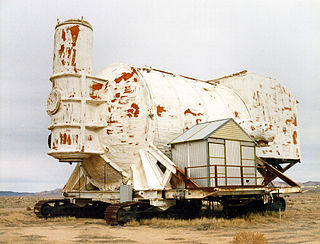
The Nevada National Security Sites, popularized as the Nevada Test Site (NTS) until 2010, is a reservation of the United States Department of Energy located in the southeastern portion of Nye County, Nevada, about 65 mi (105 km) northwest of the city of Las Vegas.

Operation Tinderbox was a series of 14 nuclear tests conducted by the United States in 1979–1980 at the Nevada Test Site. These tests followed the Operation Quicksilver series and preceded the Operation Guardian series.

Operation Storax was a series of 47 nuclear tests conducted by the United States in 1962–1963 at the Nevada Test Site. These tests followed the Operation Fishbowl series and preceded the Operation Roller Coaster series.
The United States's Niblick nuclear test series was a group of 41 nuclear tests conducted in 1963–1964. These tests followed the Operation Roller Coaster series and preceded the Operation Whetstone series.
Operation Latchkey was a series of 38 nuclear tests conducted by the United States in 1966–1967 at the Nevada Test Site. These tests followed the Operation Flintlock series and preceded the Operation Crosstie series.

Operation Crosstie was a series of 48 nuclear tests conducted by the United States in 1967–1968 at the Nevada Test Site. These tests followed the Operation Latchkey series and preceded the Operation Bowline series.

The United States's Mandrel nuclear test series was a group of 52 nuclear tests conducted in 1969–1970. These tests followed the Operation Bowline series and preceded the Operation Emery series.

Operation Hardtack II was a series of 37 nuclear tests conducted by the United States in 1958 at the Nevada Test Site. These tests followed the Operation Argus series and preceded the Operation Nougat series.
The United States's Praetorian nuclear test series was a group of 19 nuclear tests conducted in 1981–1982. These tests followed the Operation Guardian series and preceded the Operation Phalanx series.
The United States's Phalanx nuclear test series was a group of 18 nuclear tests conducted in 1982–1983. These tests followed the Operation Praetorian series and preceded the Operation Fusileer series.
Operation Fusileer was a series of 16 nuclear tests conducted by the United States in 1983–1984 at the Nevada Test Site. These tests followed the Operation Phalanx series and preceded the Operation Grenadier series.

Operation Charioteer was a series of 16 nuclear tests conducted by the United States in 1985–1986 at the Nevada Test Site. These tests followed the Operation Grenadier series and preceded the Operation Musketeer series.

The United States's Touchstone nuclear test series was a group of 13 nuclear tests conducted in 1987–1988. These tests followed the Operation Musketeer series and preceded the Operation Cornerstone series.
The United States's Cornerstone nuclear test series was a group of 11 nuclear tests conducted in 1988–1989. These tests followed the Operation Touchstone series and preceded the Operation Aqueduct series.
The United States's Aqueduct nuclear test series was a group of 10 nuclear tests conducted in 1989–1990. These tests followed the Operation Cornerstone series and preceded the Operation Sculpin series.
The United States's Sculpin nuclear test series was a group of 7 nuclear tests conducted between October 1990 and September 1991. These tests followed the Operation Aqueduct series and preceded the Operation Julin series.
The United States's Arbor nuclear test series was a group of 18 nuclear tests conducted in 1973–1974. These tests followed the Operation Toggle series and preceded the Operation Bedrock series.

The United States's Flintlock nuclear test series was a group of 47 nuclear tests conducted in 1965–1966. These tests followed the Operation Whetstone series and preceded the Operation Latchkey series.

Yucca Flat is a closed desert drainage basin, one of four major nuclear test regions within the Nevada Test Site (NTS), and is divided into nine test sections: Areas 1 through 4 and 6 through 10. Yucca Flat is located at the eastern edge of NTS, about ten miles (16 km) north of Frenchman Flat, and 65 miles (105 km) from Las Vegas, Nevada. Yucca Flat was the site for 739 nuclear tests – nearly four of every five tests carried out at the NTS.

Operation Project 58/58A was a series of 4 nuclear tests conducted by the United States in 1957–1958 at the Nevada Test Site. These tests followed the Operation Plumbbob series and preceded the Operation Hardtack I series.
























